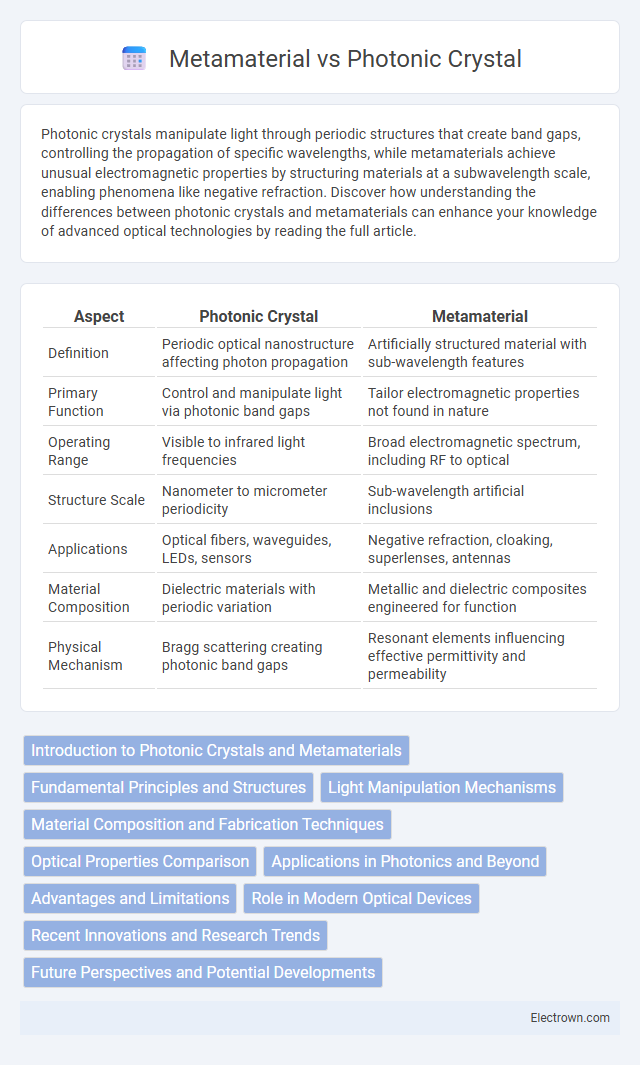Photonic crystals manipulate light through periodic structures that create band gaps, controlling the propagation of specific wavelengths, while metamaterials achieve unusual electromagnetic properties by structuring materials at a subwavelength scale, enabling phenomena like negative refraction. Discover how understanding the differences between photonic crystals and metamaterials can enhance your knowledge of advanced optical technologies by reading the full article.
Table of Comparison
| Aspect | Photonic Crystal | Metamaterial |
|---|---|---|
| Definition | Periodic optical nanostructure affecting photon propagation | Artificially structured material with sub-wavelength features |
| Primary Function | Control and manipulate light via photonic band gaps | Tailor electromagnetic properties not found in nature |
| Operating Range | Visible to infrared light frequencies | Broad electromagnetic spectrum, including RF to optical |
| Structure Scale | Nanometer to micrometer periodicity | Sub-wavelength artificial inclusions |
| Applications | Optical fibers, waveguides, LEDs, sensors | Negative refraction, cloaking, superlenses, antennas |
| Material Composition | Dielectric materials with periodic variation | Metallic and dielectric composites engineered for function |
| Physical Mechanism | Bragg scattering creating photonic band gaps | Resonant elements influencing effective permittivity and permeability |
Introduction to Photonic Crystals and Metamaterials
Photonic crystals are periodic optical nanostructures that affect the motion of photons, creating photonic band gaps to control light propagation efficiently. Metamaterials are artificially engineered composites designed to exhibit properties not found in natural materials, such as negative refractive index, enabling novel electromagnetic wave manipulation. Understanding the fundamental differences between photonic crystals and metamaterials can help you tailor advanced optical devices for applications in telecommunications, sensing, and imaging.
Fundamental Principles and Structures
Photonic crystals are periodic dielectric structures designed to affect the motion of photons by creating photonic band gaps through Bragg scattering, enabling control over light propagation and localization. Metamaterials consist of artificially engineered subwavelength unit cells, often metallic, that achieve extraordinary electromagnetic properties such as negative refractive index by manipulating effective permittivity and permeability. The fundamental difference lies in photonic crystals relying on periodic dielectric contrasts to control light via photonic band gaps, while metamaterials derive their behavior from tailored resonant inclusions that interact with electromagnetic waves beyond natural material responses.
Light Manipulation Mechanisms
Photonic crystals manipulate light through periodic dielectric structures that create photonic band gaps, controlling photon propagation by Bragg scattering. Metamaterials achieve light manipulation via engineered subwavelength unit cells that induce tailored electromagnetic responses, such as negative refractive indices. Both utilize structural design to influence light-matter interaction but differ fundamentally in scale and operating principles.
Material Composition and Fabrication Techniques
Photonic crystals consist of periodic dielectric materials designed to affect the motion of photons, typically fabricated using techniques such as electron-beam lithography, self-assembly, or layer-by-layer deposition. Metamaterials are engineered from subwavelength metallic or dielectric inclusions arranged to create unique electromagnetic properties not found in natural materials, often produced through advanced nanofabrication methods like focused ion beam milling or 3D printing. Understanding these distinct material compositions and fabrication techniques helps optimize Your design choices for applications requiring precise control of light-matter interactions.
Optical Properties Comparison
Photonic crystals exhibit periodic dielectric structures that create photonic band gaps, effectively controlling the flow of light through Bragg scattering and enabling precise wavelength filtering. Metamaterials possess engineered subwavelength inclusions that produce negative refractive indices and unconventional electromagnetic responses not found in natural materials. While photonic crystals manipulate light via periodicity-induced band structures, metamaterials achieve unique optical properties through tailored resonances and effective medium parameters.
Applications in Photonics and Beyond
Photonic crystals manipulate light through periodic dielectric structures, enabling advanced applications in optical fibers, waveguides, and laser cavities with enhanced light confinement and control. Metamaterials, engineered with subwavelength patterns, exhibit unique electromagnetic properties such as negative refraction and superlensing, impacting fields beyond photonics including cloaking devices, antenna design, and sensing technologies. Both materials play critical roles in developing next-generation optical communication, imaging systems, and novel sensors with tailored electromagnetic responses.
Advantages and Limitations
Photonic crystals offer precise control over light propagation through periodic dielectric structures, enabling efficient waveguiding and optical filtering with low loss, but their fabrication complexity and limited bandwidth restrict practical applications. Metamaterials provide exceptional electromagnetic properties, such as negative refractive index and subwavelength imaging, which are unattainable with natural materials; however, they often suffer from high losses, narrow operational frequencies, and challenging scalability. Both materials present unique advantages for advanced photonics, yet balancing fabrication feasibility, operational bandwidth, and loss remains critical for real-world integration.
Role in Modern Optical Devices
Photonic crystals manipulate light by creating periodic dielectric structures that control the flow of photons, enabling improved performance in optical fibers, lasers, and sensors. Metamaterials exhibit unique electromagnetic properties not found in nature, such as negative refractive index, which enhances applications in superlenses, cloaking devices, and advanced waveguides. Your choice between the two depends on whether precise light manipulation or novel electromagnetic responses are more critical for your optical device design.
Recent Innovations and Research Trends
Recent innovations in photonic crystals emphasize advanced tunability and integration with nanoscale devices to control light propagation at unprecedented precision, enabling breakthroughs in optical computing and sensing. Metamaterial research trends focus on dynamic reconfigurability and nonlinearity, facilitating applications in cloaking, superlensing, and wireless power transfer. Your understanding of these developments can enhance the design of next-generation photonic and electromagnetic systems.
Future Perspectives and Potential Developments
Photonic crystals and metamaterials both hold transformative potential for future optical technologies, with photonic crystals enabling precise control of light transport at the nanoscale for advanced communications and quantum computing. Metamaterials, characterized by their engineered subwavelength structures, promise breakthroughs in invisibility cloaking, superlensing, and dynamic tunability beyond natural material limits. Emerging developments in fabrication techniques and integration with AI-driven design algorithms are expected to accelerate their deployment in next-generation sensors, wireless devices, and miniaturized photonic circuits.
photonic crystal vs metamaterial Infographic

 electrown.com
electrown.com